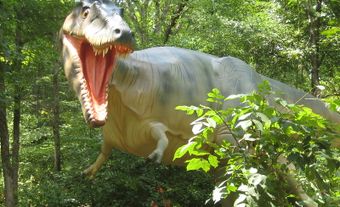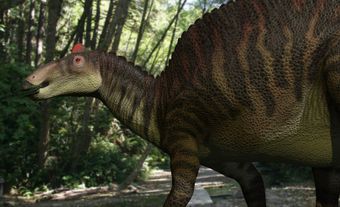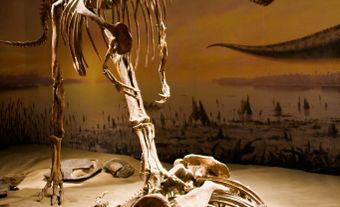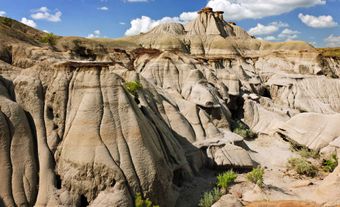Thanatotheristes (pronounced tha-NAH-toe-THER-ist-ees) is a genus of large, meat-eating dinosaur (theropod). Thanatotheristes means “Reaper of Death,” reflecting the dinosaur’s position as the top predator in its ecosystem. Thanatotheristes lived approximately 79.5 million years ago, making it the oldest tyrannosaur from Canada, and one of the oldest in the world. Its close relative, Tyrannosaurus rex, appeared about 11 million years after Thanatotheristes. Thanatotheristes is also the most-recent tyrannosaur discovered in Canada — the last species was named in 1970. Ranchers John and Sandra De Groot found bone fragments along the Bow River, Alberta in 2008. The remains were recognized as a new species 10 years later by Jared Voris, a graduate student at the University of Calgary.
Description
Paleontologists learned about Thanatotheristes through about 10 skull fragments, including jaws and teeth, from a large subadult individual. Despite the incomplete nature of the specimen, it preserves sufficient information to determine the dinosaur’s appearance and evolutionary relationships with other tyrannosaurids from Asia and North America.

Paleontologists believe Thanatotheristes and Albertosaurus, another meat-eating dinosaur discovered in Canada, grew to be approximately the same size. Both dinosaurs were up to 10 m in length — about the length of a school bus — and weighed between 1.3 and 2.5 tonnes. Like other famous members of the Tyrannosauridae family, Thanatotheristes walked on two legs. It had powerful hindlimbs and short forelimbs. Each of their hands had only two fingers. At the end of their short necks hung a large skull that reached up to 1 m in length.
Thanatotheristes is a member of the tyrannosaurine subfamily. This means that Thanatotheristes is more closely related to Tyrannosaurus rex than Albertosaurus. Members of the tyrannosaurine subfamily were more robust and had relatively shorter legs than tyrannosaurids belonging to the subfamily Albertosaurinae (Albertosaurus and Gorgosaurus). Because of these differences, some paleontologists have suggested that albertosaurines may have been swifter predators than tyrannosaurines.
Thanatotheristes had more teeth than most other tyrannosaurids: 38-42 teeth in its upper jaw and at least 32 teeth in its lower jaw. The teeth were serrated, like a steak knife, for slicing through flesh.
Although nothing is known about the skin texture of Thanatotheristes, its body was likely covered with scales, similar to Albertosaurus and other tyrannosaurids. Thanatotheristes had very prominent vertical bony ridges on its snout, which were likely covered by large scales or keratin in life. These would have been used for display, to attract a mate or to scare an adversary. Among tyrannosaurids, only Daspletosaurus and Tyrannosaurus rex possess somewhat similar facial ornamentation. This suggests that Thanatotheristes may have been a primitive relative of these species.
Range and Habitat

Fossil remains of Thanatotheristes are found in southern Alberta in a rock interval of the Foremost Formation called the Taber Coal Zone.
Thanatotheristes lived on the subtropical coastal plain of the western shore of the Western Interior Seaway, an inland sea that connected the modern-day Arctic Ocean to the Gulf of Mexico, dividing North America in two. It lived during a time when sea levels were dropping and the Western Interior Seaway was retreating to the east towards modern-day Saskatchewan.
It is believed that Thanatotheristes belonged to a group of “long-snouted” tyrannosaurids that lived in southernmost Alberta and Montana.
Reproduction and Development
No eggs or eggshell fragments have been discovered for Thanatotheristes or any other tyrannosaurid. This could be because tyrannosaurs nested in environments where it was unlikely for their eggs to be buried by river sediment and eventually fossilized. However, a recent study suggested that tyrannosaurs may have laid soft-shelled eggs, like many lizards and turtles. Soft-shelled eggs are less likely to fossilize than hard-shelled eggs.
Diet
Thanatotheristes, like all tyrannosaurids, were carnivores. Tooth marks on bones left by tyrannosaurids indicate that mature individuals commonly fed on dinosaurian megaherbivores, such as duckbilled dinosaurs and horned dinosaurs. The only herbivores known to date that coexisted with Thanatotheristes are the horned dinosaur Xenoceratops and the dome-headed Colepiocephale. Large tyrannosaurines like Tyrannosaurus rex and Daspletosaurus, are known to have pulverized and ingested bones while feeding. It is likely that Thanatotheristes did the same.
Behavior
The strong jaws of Thanatotheristes allowed it to capture and hold onto struggling prey. By comparison, most other theropods only delivered slashing bites, much like Komodo dragons today. The small forelimbs of tyrannosaurids were too short to be used to capture prey.
Nothing is known about the social behavior of Thanatotheristes.
Discovery

In 2008, while walking along the Bow River, local ranchers John and Sandra De Groot discovered fossilized bones on the shore. When a paleontologist from the Royal Tyrrell Museum came to a local school in 2010 to give a presentation, they showed him the bones. The paleontologist immediately recognized the bones as belonging to a tyrannosaurid. One was an upper jaw bone and two were lower jaw bones containing broken teeth.
Mr. De Groot led a team from the Museum to the site where he had discovered the bones, and they recovered additional skull fragments. The De Groots presented the bones they had previously discovered to the Royal Tyrrell Museum. The Museum tentatively identified them as belonging to Daspletosaurus.
In 2018, Jared Voris, a graduate student at the University of Calgary who was studying tyrannosaurids, came across the De Groot’s specimen at the Royal Tyrrell Museum. He recognized that it differed from Daspletosaurus and all other known tyrannosaurs in many key characteristics. After studying the specimen, he concluded that it represented an entirely new species of tyrannosaurid. That summer, he and a team from the Museum returned to the site where the specimen was discovered. They searched for bone elements that may have been left behind and tried to determine at which level within the rock formation the dinosaur came from (known as its stratigraphic position). Although no additional bones were found, it was determined that the specimen had eroded out of a cliff near the river. In 2020, the specimen was given the name Thanatotheristes degrootorum, which means “the De Groots’ Reaper of Death,” to reflect the animal’s position as the top predator of its ecosystem and to honor John and Sandra DeGroot for their discovery. The following year, the Royal Canadian Mint commemorated the discovery and naming of Thanatotheristes by issuing a $20 engraved, collectible silver coin.

 Share on Facebook
Share on Facebook Share on X
Share on X Share by Email
Share by Email Share on Google Classroom
Share on Google Classroom



